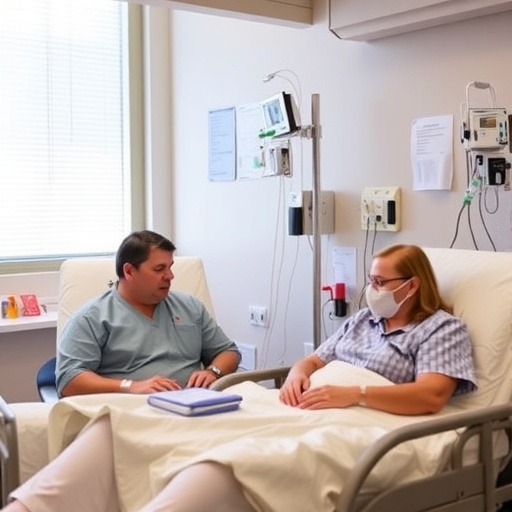Houston, TX (November 8, 2025) — The financial burden of emergency dialysis is extraordinarily high, with costs estimated to be eight times greater than those associated with scheduled, in-center dialysis treatments. Addressing this pressing issue, a pioneering study conducted in Travis County, Texas, elucidates the profound impact of a newly implemented transitional dialysis program designed specifically for uninsured patients experiencing end-stage kidney disease (ESKD). This innovative approach has demonstrated a substantial reduction in emergency department visits and hospital admissions for emergency dialysis by enabling access to regular outpatient dialysis services. The crucial insights from this investigation are slated for presentation at the prestigious ASN Kidney Week 2025, held from November 5 to 9.
The transitional dialysis program was initiated by Central Health, a publicly funded health organization that caters to uninsured and vulnerable patient populations within Travis County. Launched in November 2022, this program was conceptualized to bridge the gap for uninsured individuals who traditionally face significant barriers in accessing standard outpatient dialysis treatments. The initiative sought to provide a structured, in-center outpatient dialysis treatment pathway, aiming to improve clinical outcomes and reduce reliance on costly emergency care services.
Over a monitoring period spanning from November 2022 through December 2024, researchers meticulously evaluated clinical data for 101 patients enrolled in the pilot program. Their assessment revealed a marked decrease in the incidence of emergency dialysis sessions administered within hospital settings, indicating improved management of chronic kidney failure through outpatient care. This outcome reflects enhanced patient stability and continuity of care, as the program ensured timely initiation of scheduled dialysis rather than episodic emergency interventions.
Furthermore, the study highlights biomechanical and surgical advancements in vascular access among participants. Within the first year of program enrollment, the majority of patients achieved permanent dialysis access, either via arteriovenous fistulas (AVF) or peritoneal dialysis catheters. AVFs represent the gold-standard vascular access due to their durability and lower infection rates, while peritoneal catheters offer a home-based dialysis alternative, expanding patient autonomy. The successful placement of these devices is indicative of improved clinical coordination and patient preparation within the transitional program framework.
A pivotal component of the program was the provision of insurance coverage for outpatient dialysis and transplantation evaluation, facilitated by Central Health. This coverage significantly alleviated financial barriers for uninsured patients, thereby fostering equitable access to nephrology services and kidney transplant listings. To date, this insurance facilitation has culminated in 18 patients being successfully listed for kidney transplantation, with two individuals receiving living donor transplants, representing critical milestones in patient care and resource optimization.
Dr. Michelle Lubetzky of The University of Texas, Austin, the study’s corresponding author, emphasized the transformative potential of the program, noting that Texas currently lacks a safety-net insurance plan for patients ineligible for Medicare or Medicaid. She advocates that this pilot model presents a replicable, cost-effective strategy that not only improves patient outcomes but also reduces the utilization of emergency healthcare resources—a model that could be adopted by states and municipalities lacking similar safety nets.
The mechanisms driving the program’s success involve multidisciplinary coordination among nephrologists, vascular surgeons, social workers, and care coordinators to ensure expedited placement of dialysis access and initiation of transplantation evaluation. This integrative approach minimizes delays that typically exacerbate patient morbidity and healthcare expenditure in uninsured populations. Additionally, by sidestepping emergency dialysis, the program mitigates the risk of complications such as hemodynamic instability, infection, and hospitalization-associated morbidity that often accompany unplanned dialysis initiation.
Emergency dialysis is associated not only with elevated costs but also with suboptimal clinical outcomes, heightened rates of hospitalization, and increased mortality. By proactively transitioning patients to outpatient dialysis, the program enhances hemodynamic stability and optimizes fluid and electrolyte management—key determinants of patient survival and quality of life. This strategy also fosters patient education and engagement, promoting adherence to treatment regimens and early identification of complications.
The integration of transplant evaluation within the program further underscores the commitment to comprehensive kidney care. Kidney transplantation remains the preferred modality for suitable patients with ESKD, offering improved survival and quality of life compared to maintenance dialysis. By facilitating early assessment and listing for transplantation, the program expedites access to curative therapy, reducing prolonged dialysis dependence and associated complications.
This study exemplifies how tailored health policy interventions, grounded in clinical evidence and social equity, can address complex healthcare disparities. By leveraging public funds and strategic program design, Central Health has paved the way for sustainable models of chronic kidney disease management among uninsured populations. The findings support advocacy for expanded funding and similar programs nationwide, aligning with broader public health goals to reduce health inequities and optimize resource allocation.
ASN Kidney Week 2025 will provide the global nephrology community with an opportunity to delve deeper into the data and methodologies underpinning this study. The meeting, renowned for disseminating advances in kidney research and clinical practice, will spotlight the implications of such transitional programs in reshaping healthcare delivery for marginalized populations. Engagement with this discourse is vital for transplant centers, policymakers, and clinicians striving to enhance equity in nephrology care on a systemic scale.
In summary, the Travis County transitional dialysis program offers a compelling blueprint for addressing the intertwined challenges of uninsured status, healthcare access, and kidney failure management. Through strategic insurance coverage, clinical coordination, and patient-centered care pathways, it significantly decreases reliance on emergent dialysis interventions and improves longitudinal patient outcomes. This model articulates a vision for health systems that prioritize prevention, equity, and sustainable management of chronic diseases, especially in underserved communities.
Subject of Research: Transitional Dialysis Program for Uninsured Patients with End-Stage Kidney Disease (ESKD)
Article Title: Benefits of a Dedicated Dialysis Program for Uninsured Patients with ESKD in Texas
News Publication Date: November 8, 2025
Web References:
- American Society of Nephrology: www.asn-online.org
- ASN Facebook: https://www.facebook.com/AmericanSocietyofNephrology/
- ASN X (Twitter): https://twitter.com/asnkidney
- ASN LinkedIn: https://www.linkedin.com/company/american-society-of-nephrology
- ASN Instagram: https://www.instagram.com/asnkidney/
Keywords: Health and medicine, end-stage kidney disease, emergency dialysis, outpatient dialysis, vascular access, arteriovenous fistula, peritoneal dialysis catheter, uninsured patients, kidney transplantation, health equity, health policy, chronic kidney disease management




